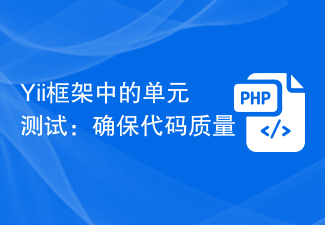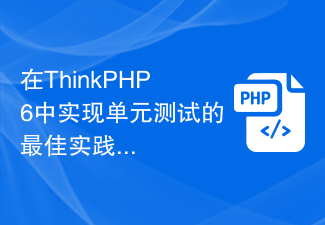Best practices for implementing unit testing in ThinkPHP6
With the requirements for rapid iteration and efficient delivery in modern software development, unit testing has become an indispensable automated testing method. In the PHP language, the popularity of unit testing frameworks eliminates the need for developers to manually test each function and method. Instead, they can write test cases to automatically check the correctness of the code. In ThinkPHP6, the PHPUnit unit testing framework is integrated into the framework by default and has quite complete functions and excellent performance. This article will introduce the best practices on how to implement unit testing in ThinkPHP6, and share some experiences and techniques in practice.
1. Install the PHPUnit unit test framework
ThinkPHP6 framework integrates the PHPUnit unit test framework by default. We only need to introduce dependencies in Composer. In subsequent development, every time we need to run a unit test, we only need to execute the following command in the terminal:
php think test
Before executing this command, we need to ensure that PHP7.2 and above have been installed for the project. And the Composer package manager is installed. In the terminal, switch to the project root directory, and then execute the following command to install PHPUnit:
composer require phpunit/phpunit
Only after the PHP development environment and PHPUnit unit testing framework are successfully installed, we can start to implement unit testing.
2. Method of writing unit tests
Unit tests depend on various modules and their associations in the business system. Therefore, before writing unit tests, we need to first master the core code of the business system. Model relationships and business requirements.
In ThinkPHP6, we can write unit tests by creating another folder called tests and then placing test cases in it. A test case should be one or more tests for PHP code, and we can write a test class to implement it.
In the test class, we can initialize and clear the test data through the setUp() and tearDown() methods, or we can use the specific function provided by PHPUnit to assert between an expected value and an actual value. The relationship between them, so as to test whether our code conforms to the expected logic. The following is a simple test class:
<?php
use PHPUnitFrameworkTestCase;
use appmodelUser;
class UserTest extends TestCase
{
protected $user;
protected function setUp(): void
{
$this->user = new User(['name' => 'test', 'email' => 'test@test.com']);
}
public function testGetName()
{
$this->assertSame($this->user->name, 'test');
}
public function testGetEmail()
{
$this->assertSame($this->user->email, 'test@test.com');
}
protected function tearDown(): void
{
unset($this->user);
}
}In the above test class, we first initialized the $user object through the setUp() method, and then tested whether its member variables $name and $email were correctly set. Setup and assignment. After the test is completed, we use the tearDown() method to delete the $user object from memory.
3. Unit testing in practical applications
In practical applications, we need to consider unit testing of the business system model and controller. In ThinkPHP6, we can use helper functions to simulate requests and responses, and use database operation classes to directly read test data. The following is an example of a test case for a model class:
<?php
use PHPUnitFrameworkTestCase;
use appmodelGoods;
class GoodsTest extends TestCase
{
public function testGetGoodsById()
{
// 模拟请求
$request = request();
$request->get(['id' => 1]);
// 模拟响应
$response = app()->http->run();
$content = $response->getContent();
// 断言响应是否符合预期
$this->assertSame(
'{"id":1,"name":"Apple iPhone 11","price":5999}',
$content
);
}
}In the above test case, we wrote a test method to simulate an HTTP GET request through the $request object to obtain product information corresponding to product id=1. Then use the $app->http->run() method to simulate the response, return the corresponding data in the server to the unit testing framework, and assert whether the return value meets expectations. If the return value is correct, the test passes, otherwise the test is considered failed.
In the controller, we can use frameworks such as Mockery to simulate, inject objects and other operations to test whether the controller we wrote ourselves meets expectations.
In practical applications, we also need to consider issues such as comprehensive test case coverage and efficient running of unit test suites. These problems need to be solved according to business needs in actual development, and third-party tools can be used to improve test coverage and testing efficiency.
4. Summary
In ThinkPHP6, implementing unit testing only depends on PHP itself and the PHPUnit unit testing framework. When writing test cases, we need to master the core code, model relationships and business requirements of the business system, and consider various special situations and outliers in the test cases. In practical applications, we also need to consider issues such as comprehensive test case coverage and efficient running of unit test suites. In short, unit testing plays a vital role in solving bugs in business systems, improving development efficiency, enhancing code quality, and reducing system maintenance costs.
The above is the detailed content of Best practices for implementing unit testing in ThinkPHP6. For more information, please follow other related articles on the PHP Chinese website!
 Yii框架中的单元测试:确保代码质量Jun 21, 2023 am 10:57 AM
Yii框架中的单元测试:确保代码质量Jun 21, 2023 am 10:57 AM随着软件开发的日益复杂化,确保代码质量变得越来越重要。在Yii框架中,单元测试是一种非常强大的工具,可以确保代码的正确性和稳定性。在本文中,我们将深入探讨Yii框架中的单元测试,并介绍如何使用Yii框架进行单元测试。什么是单元测试?单元测试是一种软件测试方法,通常用于测试一个模块、函数或方法的正确性。单元测试通常由开发人员编写,旨在确保代码的正确性和稳定性。
 Go语言中的单元测试与集成测试Jun 02, 2023 am 10:40 AM
Go语言中的单元测试与集成测试Jun 02, 2023 am 10:40 AM随着软件开发变得越来越复杂,测试也变得越来越重要。在实际开发中,有两种常见的测试方法:单元测试和集成测试。在这篇文章中,我们将聚焦于Go语言中的这两种测试方法。一、单元测试单元测试是一个独立的测试单元,用于测试程序中的逻辑单元,比如函数、方法、类等。这些测试通常由开发人员自己编写,用于验证程序的各个单元是否按照预定的规则工作。在Go语言中,我们可以使用标准库
 用ThinkPHP6实现单元测试Jun 20, 2023 pm 11:52 PM
用ThinkPHP6实现单元测试Jun 20, 2023 pm 11:52 PMThinkPHP是一款非常流行的PHP开发框架,它具有开发效率高、学习成本低、灵活性强等优点。对于一个优秀的开发团队来说,单元测试是保证代码质量的一种必要手段。本篇文章将介绍如何使用ThinkPHP6框架进行单元测试,以提高项目的稳定性和开发效率。一、什么是单元测试?单元测试是指对软件中的最小可测试单元进行检查和验证的一种测试方法。在PHP开发中,单元测试可
 php如何使用PHPUnit和Mockery进行单元测试?May 31, 2023 pm 04:10 PM
php如何使用PHPUnit和Mockery进行单元测试?May 31, 2023 pm 04:10 PM在PHP项目开发中,单元测试是一项很重要的任务。PHPUnit和Mockery是两个相当流行的PHP单元测试框架,其中PHPUnit是一个被广泛使用的单元测试工具,而Mockery则是一个专注于提供统一而简洁的API以创建和管理对象Mock的对象模拟工具。通过使用PHPUnit和Mockery,开发人员可以快速高效地进行单元测试,以确保代码库的正确性和稳定性
 如何进行PHP单元测试?May 12, 2023 am 08:28 AM
如何进行PHP单元测试?May 12, 2023 am 08:28 AM在Web开发中,PHP是一种流行的语言,因此对于任何人来说,对PHP进行单元测试是一个必须掌握的技能。本文将介绍什么是PHP单元测试以及如何进行PHP单元测试。一、什么是PHP单元测试?PHP单元测试是指测试一个PHP应用程序的最小组成部分,也称为代码单元。这些代码单元可以是方法、类或一组类。PHP单元测试旨在确认每个代码单元都能按预期工作,并且能否正确地与
 Go语言中的单元测试和集成测试:最佳实践Jun 17, 2023 pm 04:15 PM
Go语言中的单元测试和集成测试:最佳实践Jun 17, 2023 pm 04:15 PM在软件开发中,测试是一个极其重要的环节。测试不仅可以帮助开发人员找出代码中的错误,还可以提高代码的质量和可维护性。在Go语言中,测试是使用GoTest工具完成的。GoTest支持单元测试和集成测试两种测试方式。在本文中,我们将介绍Go语言中单元测试和集成测试的最佳实践。单元测试单元测试是指对程序中的最小可测试单元进行测试。在Go语言中,一个函数或方法就是
 如何使用PHPUnit进行PHP单元测试May 12, 2023 am 08:13 AM
如何使用PHPUnit进行PHP单元测试May 12, 2023 am 08:13 AM随着软件开发行业的发展,测试逐渐成为了不可或缺的一部分。而单元测试作为软件测试中最基础的一环,不仅能够提高代码质量,还能够加快开发者开发和维护代码的速度。在PHP领域,PHPUnit是一个非常流行的单元测试框架,它提供了各种功能来帮助我们编写高质量的测试用例。在本文中,我们将介绍如何使用PHPUnit进行PHP单元测试。安装PHPUnit在使用PHPUnit
 在ThinkPHP6中实现单元测试的最佳实践Jun 21, 2023 am 10:31 AM
在ThinkPHP6中实现单元测试的最佳实践Jun 21, 2023 am 10:31 AM在ThinkPHP6中实现单元测试的最佳实践随着现代软件开发中的快速迭代和高效交付的要求,单元测试已经成为一种不可或缺的自动化测试方法。在PHP语言中,单元测试框架的流行使得开发者不必再手动测试每个函数和方法,而是可以编写测试用例自动化地检查代码的正确性。在ThinkPHP6中,PHPUnit单元测试框架被默认集成进了框架内部,并且具有相当完备的功能和优秀的


Hot AI Tools

Undresser.AI Undress
AI-powered app for creating realistic nude photos

AI Clothes Remover
Online AI tool for removing clothes from photos.

Undress AI Tool
Undress images for free

Clothoff.io
AI clothes remover

AI Hentai Generator
Generate AI Hentai for free.

Hot Article

Hot Tools

Dreamweaver CS6
Visual web development tools

ZendStudio 13.5.1 Mac
Powerful PHP integrated development environment

Atom editor mac version download
The most popular open source editor

SublimeText3 Mac version
God-level code editing software (SublimeText3)

Safe Exam Browser
Safe Exam Browser is a secure browser environment for taking online exams securely. This software turns any computer into a secure workstation. It controls access to any utility and prevents students from using unauthorized resources.






